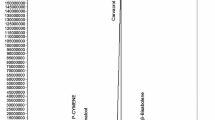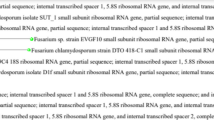Abstract
Nanotechnology and its use in medicine is a rapidly emerging arena of exploration. Various procedures are applied to synthesize materials at the nanoscale. Among such methods, biosynthesis is an eco-friendly approach that has several advantages over conventional methods. In the present report, we have synthesized gold nanoparticles (AuNPs) using marine fungus Alternaria chlamydospora for the first time at the international level. The materialization of AuNPs was initially observed by means of analysis using UV–Vis spectrophotometry at regular intervals. The role of the natural compounds of fungi in aiding the synthesis process was identified by the FT-IR spectra. Further, the size, shape and nature of such materials were analyzed by adopting procedures that use tools such as XRD, SEM and TEM. Analyses of morphology using electron microscopy disclosed that majority of the synthesized AuNPs were spherical and belonged to the nano-regime. The antioxidant, antibacterial and cytotoxicity studies indicated a dose-dependent response by the AuNPs. Further, the inhibition of DPPH radical by AuNPs was elucidated by analyzing the half-maximal inhibitory concentration (IC50) value (224.97 ± 0.56 µg/mL). The inhibiting effect of AuNPs on the growth of four different bacterial pathogens with increasing concentrations of the nanomaterial was noted by measuring the zone of inhibition. The cytotoxicity of the materials was tested against A549 cell lines via MTT assay to determine their anticancer effect. The IC50 value was 121.79 µg/mL. These significant outcomes of the research specify the potential of AuNPs and identify it to be a good tool for applications in pharmacology.









Similar content being viewed by others
References
Ahmed S, Ikram S et al (2016) Biosynthesis of gold nanoparticles: a green approach. J Photochem Photobiol B Biol 161:141–153
Alsamhary K, Al-Enazi N, Alshehri WA, Ameen F (2020) Gold nanoparticles synthesised by flavonoid tricetin as a potential antibacterial nanomedicine to treat respiratory infections causing opportunistic bacterial pathogens. Microb Pathog 139:103928
Ameen F, AlYahya SA, Bakhrebah MA et al (2018) Flavonoid dihydromyricetin-mediated silver nanoparticles as potential nanomedicine for biomedical treatment of infections caused by opportunistic fungal pathogens. Res Chem Intermed. https://doi.org/10.1007/s11164-018-3409-x
Ameen F, Dawoud T, AlNadhari S (2021a) Ecofriendly and low-cost synthesis of ZnO nanoparticles from Acremonium potronii for the photocatalytic degradation of azo dyes. Environ Res 202:111700
Ameen F, Stephenson SL, AlNadhari S, Yassin MA (2021b) Isolation, identification and bioactivity analysis of an endophytic fungus isolated from Aloe vera collected from Asir desert, Saudi Arabia. Bioprocess Biosyst Eng 44:1063–1070
Anuradha J, Abbasi T, Abbasi SA (2015) An eco-friendly method of synthesizing gold nanoparticles using an otherwise worthless weed pistia (Pistia stratiotes L.). J Adv Res 6:711–720
Aykul S, Martinez-Hackert E (2016) Determination of half-maximal inhibitory concentration using biosensor-based protein interaction analysis. Anal Biochem 508:97–103
Badeggi UM, Ismail E, Adeloye AO et al (2020) Green synthesis of gold nanoparticles capped with procyanidins from Leucosidea sericea as potential antidiabetic and antioxidant agents. Biomolecules 10:452
Biao L, Tan S, Meng Q et al (2018) Green synthesis, characterization and application of proanthocyanidins-functionalized gold nanoparticles. Nanomaterials 8:53
Bin-Jumah MN, Al-Abdan M, Al-Basher G, Alarifi S (2020) Molecular mechanism of cytotoxicity, genotoxicity, and anticancer potential of green gold nanoparticles on human liver normal and cancerous cells. Dose-Response 18:1559325820912154
Boroumand Moghaddam A, Namvar F, Moniri M et al (2015) Nanoparticles biosynthesized by fungi and yeast: a review of their preparation, properties, and medical applications. Molecules 20:16540–16565
Botteon CEA, Silva LB, Ccana-Ccapatinta GV et al (2021) Biosynthesis and characterization of gold nanoparticles using Brazilian red propolis and evaluation of its antimicrobial and anticancer activities. Sci Rep 11:1–16
Chakraborty A, Das A, Raha S, Barui A (2020) Size-dependent apoptotic activity of gold nanoparticles on osteosarcoma cells correlated with SERS signal. J Photochem Photobiol B Biol 203:111778
Dhillon GS, Brar SK, Kaur S, Verma M (2012) Green approach for nanoparticle biosynthesis by fungi: current trends and applications. Crit Rev Biotechnol 32:49–73
Dzimitrowicz A, Jamroz P, Gil W et al (2018) Fermented juices as reducing and capping agents for the biosynthesis of size-defined spherical gold nanoparticles. J Saudi Chem Soc 22:767–776
Francis S, Joseph S, Koshy EP, Mathew B (2017) Green synthesis and characterization of gold and silver nanoparticles using Mussaenda glabrata leaf extract and their environmental applications to dye degradation. Environ Sci Pollut Res 24:17347–17357
Gan PP, Ng SH, Huang Y, Li SFY (2012) Green synthesis of gold nanoparticles using palm oil mill effluent (POME): a low-cost and eco-friendly viable approach. Bioresour Technol 113:132–135
Gashgari R, Gherbawy Y, Ameen F, Alsharari S (2016) Molecular characterization and analysis of antimicrobial activity of endophytic fungi from medicinal plants in Saudi Arabia. Jundishapur J Microbiol. https://doi.org/10.5812/jjm.26157
Girard V, Dieryckx C, Job C, Job D (2013) Secretomes: the fungal strike force. Proteomics 13:597–608
Gong J, Mullins CB (2009) Surface science investigations of oxidative chemistry on gold. Acc Chem Res 42:1063–1073
Govindaraju K, Vasantharaja R, Suganya KSU et al (2020) Unveiling the anticancer and antimycobacterial potentials of bioengineered gold nanoparticles. Process Biochem 96:213–219
Izzi M, Sportelli MC, Tursellino L et al (2020) Gold nanoparticles synthesis using stainless steel as solid reductant: a critical overview. Nanomaterials 10:622
Jakhmola A, Vecchione R, Onesto V et al (2021) Experimental and theoretical studies on sustainable synthesis of gold sol displaying dichroic effect. Nanomaterials 11:236
Ji Y, Cao Y, Song Y (2019) Green synthesis of gold nanoparticles using a Cordyceps militaris extract and their antiproliferative effect in liver cancer cells (HepG2). Artif Cells Nanomed Biotechnol 47:2737–2745
Jiang C, Jiang Z, Zhu S et al (2021) Biosynthesis of silver nanoparticles and the identification of possible reductants for the assessment of in vitro cytotoxic and in vivo antitumor effects. J Drug Deliv Sci Technol 63:102444
Kawata K, Osawa M, Okabe S (2009) In vitro toxicity of silver nanoparticles at noncytotoxic doses to HepG2 human hepatoma cells. Environ Sci Technol 43:6046–6051
Keijok WJ, Pereira RHA, Alvarez LAC et al (2019) Controlled biosynthesis of gold nanoparticles with Coffea arabica using factorial design. Sci Rep 9:1–10
Kirkland BH, Keyhani NO (2011) Expression and purification of a functionally active class I fungal hydrophobin from the entomopathogenic fungus Beauveria bassiana in E. coli. J Ind Microbiol Biotechnol 38:327–335
Kitching M, Ramani M, Marsili E (2015) Fungal biosynthesis of gold nanoparticles: mechanism and scale up. Microb Biotechnol 8:904–917
Kowsalya E, MosaChristas K, Jaquline CRI et al (2021) Gold nanoparticles induced apoptosis via oxidative stress and mitochondrial dysfunctions in MCF-7 breast cancer cells. Appl Organomet Chem 35:e6071
Kumar P, Singh P, Kumari K et al (2011) A green approach for the synthesis of gold nanotriangles using aqueous leaf extract of Callistemon viminalis. Mater Lett 65:595–597
Li C-J, Anastas PT (2012) Green Chemistry: present and future. Chem Soc Rev 41:1413–1414
Liu R, Lead JR (2006) Partial validation of cross flow ultrafiltration by atomic force microscopy. Anal Chem 78:8105–8112
Liu X, Shan K, Shao X et al (2021) Nanotoxic effects of silver nanoparticles on normal HEK-293 cells in comparison to cancerous HeLa cell line. Int J Nanomed 16:753
Loste N, Chinarro D, Gomez M et al (2020) Assessing awareness of green chemistry as a tool for advancing sustainability. J Clean Prod 256:120392
Mittal AK, Chisti Y, Banerjee UC (2013) Synthesis of metallic nanoparticles using plant extracts. Biotechnol Adv 31:346–356
Mohamed MM, Fouad SA, Elshoky HA et al (2017) Antibacterial effect of gold nanoparticles against Corynebacterium pseudotuberculosis. Int J Vet Sci Med 5:23–29
Montano MD, Ranville J, Gardner SP (2014) Detection and characterization of engineered nanomaterials in the environment: current state-of-the-art and future directions. Report. US Environmental Protection Agency Office of Research and Development
Munawer U, Raghavendra VB, Ningaraju S et al (2020) Biofabrication of gold nanoparticles mediated by the endophytic Cladosporium species: photodegradation, in vitro anticancer activity and in vivo antitumor studies. Int J Pharm 588:119729
Muniyappan N, Pandeeswaran M, Amalraj A (2021) Green synthesis of gold nanoparticles using Curcuma pseudomontana isolated curcumin: its characterization, antimicrobial, antioxidant and anti-inflammatory activities. Environ Chem Ecotoxicol 3:117–124
Nadhe SB, Wadhwani SA, Singh R, Chopade BA (2020) Green synthesis of AuNPs by Acinetobacter sp. GWRVA25: optimization, characterization, and its antioxidant activity. Front Chem 8:474
Nayem SM, Sultana N, Haque M et al (2020) Green synthesis of gold and silver nanoparticles by using amorphophallus paeoniifolius tuber extract and evaluation of their antibacterial activity. Molecules 25:4773
Oueslati MH, Ben TL, Harrath AH (2020) Catalytic, antioxidant and anticancer activities of gold nanoparticles synthesized by kaempferol glucoside from Lotus leguminosae. Arab J Chem 13:3112–3122
Rai M, Ingle AP, Gupta IR et al (2013) Potential role of biological systems in formation of nanoparticles: mechanism of synthesis and biomedical applications. Curr Nanosci 9:576–587
Rajeshkumar S (2016) Anticancer activity of eco-friendly gold nanoparticles against lung and liver cancer cells. J Genet Eng Biotechnol 14:195–202
Srinath BS, Rai VR (2015) Biosynthesis of highly monodispersed, spherical gold nanoparticles of size 4–10 nm from spent cultures of Klebsiella pneumoniae. 3 Biotech 5:671–676
Sun B, Hu N, Han L et al (2019) Anticancer activity of green synthesised gold nanoparticles from Marsdenia tenacissima inhibits A549 cell proliferation through the apoptotic pathway. Artif Cells Nanomed Biotechnol 47:4012–4019
Uzma M, Sunayana N, Raghavendra VB et al (2020) Biogenic synthesis of gold nanoparticles using Commiphora wightii and their cytotoxic effects on breast cancer cell line (MCF-7). Process Biochem 92:269–276
Veeramani S, Narayanan AP, Yuvaraj K et al (2021) Nigella sativa flavonoids surface coated gold NPs (Au-NPs) enhancing antioxidant and anti-diabetic activity. Process Biochem. https://doi.org/10.1016/j.procbio.2021.01.004
Vijayakumar R, Devi V, Adavallan K, Saranya D (2011) Green synthesis and characterization of gold nanoparticles using extract of anti-tumor potent Crocus sativus. Phys E Low-Dimens Syst Nanostruct 44:665–671
Zuin VG, Stahl AM, Zanotti K, Segatto ML (2020) Green and sustainable chemistry in Latin America: which type of research is going on? And for what? Curr Opin Green Sustain Chem 25:100379
Acknowledgements
This research was funded by Researchers Supporting Project number (RSP-2021/364), King Saud University, Riyadh, Saudi Arabia.
Author information
Authors and Affiliations
Corresponding author
Ethics declarations
Conflict of interest
The authors declare that they have no conflict of interest.
Additional information
Publisher's Note
Springer Nature remains neutral with regard to jurisdictional claims in published maps and institutional affiliations.
Rights and permissions
About this article
Cite this article
Ameen, F., Al-Maary, K.S., Almansob, A. et al. Antioxidant, antibacterial and anticancer efficacy of Alternaria chlamydospora-mediated gold nanoparticles. Appl Nanosci 13, 2233–2240 (2023). https://doi.org/10.1007/s13204-021-02047-4
Received:
Accepted:
Published:
Issue Date:
DOI: https://doi.org/10.1007/s13204-021-02047-4




